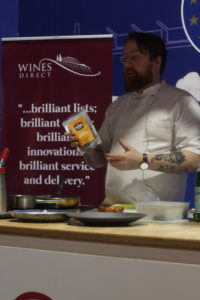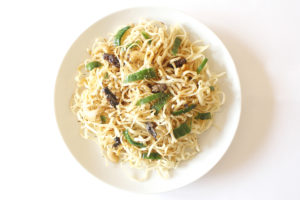A Spoonful of Insects Helps the World Go Around
Is Ireland ready to start eating insects? Whether it’s your next fine dining experience or just a scoop of crickets with your Sunday roast, what do you think? Are you ready to try adding mealworms to your diet?
As far as fast food goes, a cricket wouldn’t be your first choice. It’s a slow game and a weird food. But as the environmental and ethical questions around meat start to pile up, is Ireland ready to embrace insects as food?

Lara Hanlon sure hopes so. She’s a designer from Dublin who knows that we’re reaching a critical moment – 9 billion people by 2050 and not enough land to feed them. I guess it was keeping her up at night, so she decided to find a way to fix it through, yes, insects.
“Land for agricultural use is actually depleting,” Lara said in her June Ted talk. “It’s becoming increasingly difficult to source natural, raw, sustainable food.”
It seems crazy that a designer is interested in tackling that problem until you think about it. We don’t want to eat bugs, because they look like, well, bugs. “The visual component is so compelling, actually seeing the insect is so powerful, but not in a very positive way,” Lara says. So she started experimenting with cricket powder, which has the same protein value as traditional meats but can be used in many more diverse ways, such as baking bread.
“When I presented it as something familiar, that people might see in their health food store, then it wasn’t so difficult.”
HeadStuff food editor Laura recently took the insect challenge herself. While working at the Catex event in RDS this February, Laura listened as celebrity chef JP McMahon (who featured on a recent episode of our food podcast, With Relish) asked us to rethink the way we approach protein. On the menu: crickets and ants.

“We were invited up to give the little guys a go. Butterflies started leaping in my tummy. I hadn’t consumed an insect since I was seven,” Laura jokes. But pushing through the fear, Laura took a handful of ants and tried them out. “I placed one of the ants on my tongue and braced myself. My mouth was suddenly bursting with sour, citrus flavours! I can’t explain it – I asked if they were somehow cured in something to get these flavours, but they weren’t! Bizarre, but enjoyable, despite being ants.”
Eating crickets – a much larger and more insect-looking insect – presented a bigger challenge. “To be frank, it looked like a dried maggot, and I couldn’t seem to get past that,” Laura says. But an admiration for JP and what he stands for got her through. “I didn’t want to seem like a wimp, so I ate a bloody cricket. I clearly haven’t progressed much past the school yard. The cricket was crunchy, and dry, but tasted incredibly earthy, almost like shiitake mushroom in a way.”
JP is not the only chef to give insects a try. Alex Atala at Brazil’s D.O.M. has served raw ants on pineapple, acknowledging the role of indigenous gastronomy. Denmark’s Michelin-starred Noma has experimented with insects on the menu.
But most of us don’t have access to Michelin-starred restaurants. Is this just another fad for rich people? Or an exciting interlude on a trip to Venezuela or Vietnam? Or can us regular folk actually get involved with this new resource?
Lara’s project – called éntomo – hopes to normalise the experience of eating insects. But instead of a restaurant, she’s launched a website. In a way, éntomo is a speculative food brand, an idea that tries to bring people together.

“It’s primarily a digital resource where people can learn about entomophagy – the practice of eating insects,” Lara says. “The core output was the website where you can find recipes, health information, research findings. However, in the past few months, I’ve been focusing more on the social aspects such as events and social media platforms.”
But I ask Lara the obvious question – are people really starting to eat insects in the western world? In Ireland?
“Definitely. When I first launched the idea it was often considered a very hypothetical one here in Ireland. A lot of the accolades and attention received in the initial 1–2 years came from the Design industry but over time that began to change. Now I’m having conversations with folk in the food and innovation sector who are excited to know more about the market. It’s very encouraging!”
Okay, you’re convinced. You want to start chowing down on bugs. What are your options?
Well, the short answer is that it’s still surprisingly hard to get a hold of edible insects in the EU as they come under ‘novel food’ legislation. And a lot of what you can get is pre-processed and packaged. Jimini’s in the UK does a great line of snacks (think pepper and dried tomato grasshoppers or smoked onion and BBQ crickets), and Europe Entomophogie will sell you a bag of dried worms or a scorpion lollipop. Processed, sure, but that’s still a whole lot better than a piece of cow, in terms of the environment. But if you’re after a more authentic experience you could try out Hive.
Designed by LIVIN Farms, Hive bills itself as ‘the world’s first desktop hive for edible insects’. For just $579, you too could be growing meal worms on your kitchen bench, producing about 100 to 200 grams of bug meat per week. (In case you’re wondering what that is in real terms, it’s about 4 burger patties). The mealworms live off your kitchen scraps, moving through the system and their life cycle until they are gently ‘harvested’ so that you can use them like you would any other protein source.

It’s this mini-livestock sector that Lara from éntomo thinks has huge potential, particularly for Ireland which already has such a well-developed agricultural sector.
“Considering the strength of our agricultural industry here in Ireland I would love to see that evolve to adopt the mini-livestock sector. I mean, why not? We have the infrastructure, network, and knowledge already – we just need to exercise it in a new way.”
In the end, insects don’t need to be a replacement for your main sources of protein – just a supplement. If you replace one burger a week with mealworms, that’s a whole lot less dead cow in the world, along with all its environmental associations.

